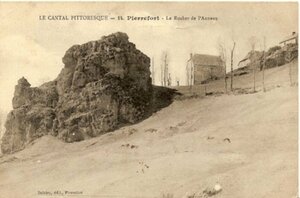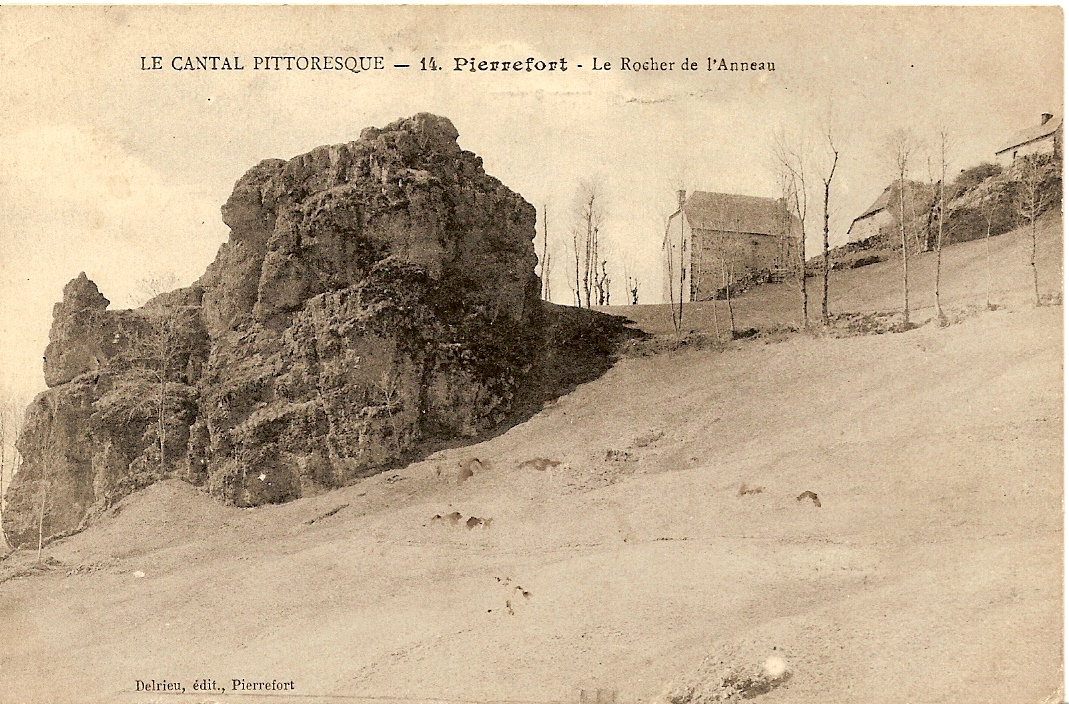




For the most part, Cantal is located on an ancient volcanic massif. The ladscape is therefore strongly marked by volcanism, as shown be the Pierrefort rock. Geologically, this rock is a neck. You can observe horizontal columns, the proof that these rocks were formed by the cooling of magma trapped in a vertical volcanic chimney.
The cooling of this magma took place rapidly, forming a dark rock called basalt (solidification occurs at about 1100-1200°C). Once formed, this rock will continue to cool. As a material cools, its volume decreases : it contracts. Trapped in the chimney, the basalt in contact with the wall cools faster than the basalt in the center. This cooling heterogeneity within a rock creates a stress that will fracture the rock. The coolest part of the rock -the part against the chimney wall- breaks down first. The fractures then progress towards the center of the chimney. In theory, these fractures should form perfect hexagons. This is the shape that best releases the energy stored in the rock. In the nature, the perfect shape is not always achieved and polyhedral structures are often observed.
Did you know that you are standing on one of the oldest and largest volcanoes in Europe ? The Cantal volcano is not a single chimney volcano ; indeed, it has multiple chimneys. It is a STRATOVOLCANO : a large massif made of a series of volcanoes that have succeeded each other over time and have also piled up on top of each other over thousands of years.
Plus de photos / More pictures

Das Departement Cantal liegt zum Großteil auf einem alten Vulkanmassiv und die Landschaft ist deshalb stark vom Vulkanismus geprägt, wie man an diesem großen Felsen sehen kann.
Geologisch gesehen, ist er ein sogenannter “neck”? Man kann die fast horizontalen Basaltorgeln und –prismen sehen, ein Beweis, dass das Gestein durch Erkalten einer Lava geformt wurde, die in einem senkrechten Vulkanschlot steckte (dyke).
Die Erkaltung dieses Magmas erfolgte schnell, aber nicht gleichmäßig und formte ein sehr hartes Gestein, das zu sechseckigen Basaltsäulen erstarrte.
Da das umliegende Gestein weicher war als der Basalt im Vulkanschlot, wurde es im Laufe der Jahrtausende abgetragen und der Vulkanschlot mit seiner erstarrten Lava kam zum Vorschein. So sieht man heute ein Gestein, das ursprünglich in der Tiefe de Erde geformt wurde.
Illustration: Schema Formung der Basaltorgeln durch Erkaltung des Magmas.
Schema Erstarrung der horizontalen Basaltorgeln im Vulkanschlot und Erscheinen durch Erosion.
Werdet schlau, Kinder: Ein ziemlich grosser Vulkan
Weisst du, dass du dich auf dem ältesten und größten Vulkan Europas befindest ?
Der Vulkan des Cantal ist kein einheitlicher Vulkan, denn er hat viele Vulkanschlote. Er ist ein Stratovulkan: ein großes Massiv, das im Laufe der Zeit durch Ausbruch vieler Vulkane während Tausenden von Jahren geformt wurde.
À compter du 1er septembre et jusqu'aux élections municipales de 2026, les délibérations du conseil municipal et le bulletin municipal seont archivés.
Ils restent consultables en Mairie.
À compter du lundi 29 septembre, vos professionnels de santé vous accueillent à la Maison de santé, 15bis rue du Carreau, derrière l'EHPAD La Mainada.